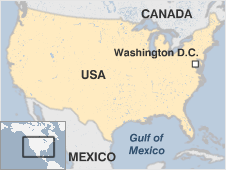 |
The USA is the world's foremost economic and military power with global interests and an unmatched global reach.
America's gross domestic product accounts for close to a quarter of the world total and its military budget is reckoned to be almost as much as the rest of the world's defence spending put together.
The country is also a major source of entertainment: American TV Hollywood films jazz blues rock and rap music are primary ingredients in global popular culture.
Overview
The United States originated in a revolution which separated it from the British Crown. The constitution drafted in 1787 established a federal system with a division of powers which has remained unchanged in form since its inception.
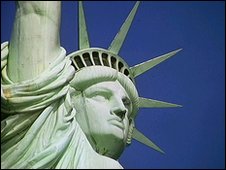 Statue of Liberty: First glimpse of the US for many past migrants
11% of population is foreign-born
52% of immigrants come from Latin America
|
The US contains a highly diverse population the product of numerous and sustained waves of immigration. Ethnic and racial diversity - the "melting pot" - is celebrated as a core element of the American ideology.
The 1964 Civil Rights Act outlawed racial and other discrimination but race continues to be a live issue.
The election of Barack Obama as the country's first African-American president in November 2008 marked a defining moment in the country's chequered history of race relations.
Freedom and prosperity
The original people of north America who made up several distinct groups of native Americans went into decline with the arrival of settlers and now constitute a minority of the population.
The early settlers came predominantly from the British Isles. Large numbers of black Africans were taken as slaves to work the plantations of the Americas while millions of Europeans in search of political freedom and economic opportunity constituted a third stage of immigration.
Today Asians from the Pacific rim and Hispanics from the southern Americas are among those seeking what their predecessors wanted - the promise of prosperity and freedom which remains one of the defining hallmarks of "the American dream".
Despite relative prosperity in recent years the gap between rich and poor remains a major challenge. More than 30 million Americans live below the official poverty line with a disproportionate percentage of these being African-Americans and Hispanics.
Furthermore the global financial crisis of 2008 has left the US facing its most challenging set of economic circumstances since the Great Depression of the 1930s.
9/11 aftermath
The terrorist attacks of September 11 2001 had a momentous impact as the country continued to re-define its role as the world's only superpower.
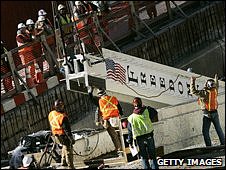 The Freedom Tower will replace the World Trade Center
|
In October 2001 the US led a military campaign in Afghanistan which unseated the Taleban regime.
In March 2003 Washington initiated military action in Iraq which led to the toppling of the Iraqi leader Saddam Hussein.
US foreign policy has often mixed the idealism of its "mission" to spread democracy with the pursuit of national self-interest.
Given America's leading role on the international stage its foreign policy aims and actions are likely to remain the subject of heated debate and criticism as well as praise.
Facts
- Full name: United States of America
- Population: 314.7 million (UN 2009)
- Capital: Washington DC
- Largest city: New York City
- Area: 9.8 million sq km (3.8 million sq miles)
- Major language: English
- Major religion: Christianity
- Life expectancy: 77 years (men) 81 years (women) (UN)
- Monetary unit: 1 US dollar = 100 cents
- Main exports: Computers and electrical machinery vehicles chemical products food and live animals military equipment and aircraft
- GNI per capita: US $47580 (World Bank 2008)
- Internet domain: .us
- International dialling code: +1
Leaders
President: Barack Obama
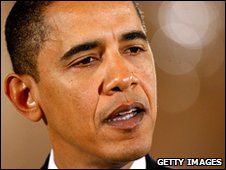
President Obama faces formidable challenges
|
Democratic Senator Barack Obama was elected the first black president of the United States in an historic election win in November 2008.
His victory over his opponent John McCain ended eight years of Republican rule in the White House.
Mr Obama re-drew the US political map as he defeated Mr McCain who struggled in vain to distance himself from the unpopular presidency of George W. Bush. As well as holding all the traditionally Democratic states the Obama campaign captured a number of states once seen as Republican strongholds.
Mr Obama clinched the Democratic Party's nomination in June 2008 following a long and bruising primary race with former first lady and fellow Democratic senator Hillary Clinton.
He ran for president on a ticket promising change and came to office riding a wave of high expectations from his supporters both at home and abroad.
President Obama inherited a formidable in-tray of problems from Mr Bush. The US is facing its worst economic crisis since the Great Depression of the 1930s and his administration must also determine the next steps in the lingering conflicts in Iraq and Afghanistan.
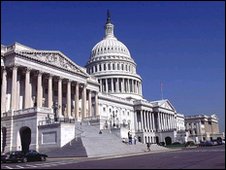 Congress government's law-making branch consists of:
The Senate - 100 members two from each state serving six-year terms
House of Representatives - 435 members serving two-year terms
|
He made reform of the healthcare system to extend coverage and reduce ballooning costs one of his top domestic priorities but a fierce debate over the form it should take slowed the progress of the legislation through Congress.
However hopes of success were boosted when the House of Representatives approved its version of the bill in November 2009.
Barack Obama is widely acknowledged as a charismatic figure and is noted for his stirring oratory. He was born in 1961 in Hawaii the son of a black Kenyan father and a white American mother.
After attending an elite Hawaii academy and Columbia University in New York he went on to Harvard Law School where he graduated in 1991.
After graduating Mr Obama practiced law and did community work in Chicago where he also became active in the Democratic Party. He won a seat in the Illinois state senate in 1996 and followed this up by winning a US Senate seat in 2004.
Mr Obama is America's 44th president and was inaugurated on 20 January 2009.
Media
The US has the most highly-developed mass media in the world. Its dramas comedies soap operas animations music videos and films have a global audience and are part of the staple fare of broadcasters worldwide.
TV is America's most popular medium. ABC CBS and NBC ruled the roost for decades until the mass take-up of cable and satellite and the arrival of the Fox network. Mainstream TV is slick fast-moving and awash with advertising. Ratings and advertising revenues spell life or death for individual shows. The switch to digital is under way; analogue TV broadcasts are set to end in mid-2009.
There are around 10000 commercial radio stations. In cities there are services to satisfy almost every taste. News sports and talk stations predominate on mediumwave (AM) with music on FM. Subscription satellite radio offers hundreds of channels and has attracted millions of customers.
Freedom of expression is guaranteed by the constitution and some stations give airtime to extreme hues of political - often right-wing - and religious thinking. Elsewhere outspoken radio "shock jocks" push at the boundaries of taste.
Public broadcasting is partly government-funded but also supported by private grants. Universities and colleges operate outlets. National Public Radio - with more than 600 member stations - offers a more highbrow mix of news debate and music without advertising. Public TV services operated by PBS have a mission to provide "quality" and educational programming.
The government sponsors TV and radio stations aimed at audiences outside the US. Lately services for audiences in the former Soviet bloc have been cut while stations targeting audiences in the Middle East and Asia have been launched.
There are more than 1500 daily newspapers in the US most of them with a local or regional readership. Hard-copy circulations are in decline as readers turn to the web.
The US is the home of the internet. By mid-2008 72.5% of Americans were online (Nielsen via InternetWorldStats.com).
The press
- USA Today - national daily
- Wall Street Journal - business daily
- Christian Science Monitor - church-owned daily
- Los Angeles Times - daily
- Washington Post - daily
- Boston Globe - daily
- New York Post - daily
- New York Times - daily
- Philadelphia Inquirer - daily
- Baltimore Sun - daily
- Chicago Tribune - daily
- Newsweek - news weekly
- Time - news weekly
- U.S.News & World Report - news weekly
Television
- ABC - major commercial network
- CBS - major commercial network
- NBC - major commercial network
- Fox - major commercial network
- CNN - pioneer of 24-hour rolling TV news operates domestic and international streams
- MTV - pioneer of music television
- HBO (Home Box Office) - pay TV network; originator of some of American TV's most critically-acclaimed programmes
- PBS (Public Broadcasting Service) - public TV serves some 350 non-commercial member stations
Radio
- NPR (National Public Radio) - non-commercial network of member stations; news information and cultural programmes
- Clear Channel - America's largest commercial radio operator owns more than 1200 stations
- CBS Radio - major commercial operator with nearly 180 stations in major markets
- ABC Radio Networks - operates flagship stations coast-to-coast
External broadcasting
- Voice of America - government-funded programmes for global audiences in many languages
- Radio Free Europe/Radio Liberty - government-funded targets eastern Europe former Soviet Union and the Caucasus in local languages
- Radio Free Asia - government funded targets China North Korea and southeast Asia
- Al-Hurra - government-funded satellite TV for Middle East
- Radio Sawa - government-funded Arabic-language radio for Middle East
- Radio Farda - government-funded Persian-language radio
- Radio and TV Marti - government-funded services for Cuba
News agencies
- Associated Press
- Bloomberg Business News
-
UPI
AFRICA | ASIA-PACIFIC | AMERICAS | EUROPE | MIDDLEEAST | SOUTHASIA
Mauritania Mauritius Morocco Mozambique Namibia Niger Nigeria Republic-of-congo Rwanda Sao-tome-and-principe Senegal Seychelles Sierra-leone Somalia South-africa Sudan Swaziland Tanzania The-gambia Togo Tunisia Uganda zambia Zimbabwe Australia Brunei Burma Cambodia China East-timor Fiji Indonesia Japan Kazakhstan Kiribati Kyrgyzstan Laos Malaysia Marshall-islands Micronesia Mongolia Nauru New-zealand North-korea Palau Papua-new-guinea Samoa Singapore Solomon-islands South-korea Taiwan Tajikistan Thailand The-philippines Tonga Turkmenistan Tuvalu Uzbekistan Vanuatu Vietnam Antigua-and-barbuda Argentina Bahamas Barbados Belize Bolivia Brazil Canada Chile Colombia Costa-rica Cuba Dominica Dominican-republic Ecuador El-salvador Grenada Guatemala GuyanaHaiti Honduras Jamaica Mexico Nicaragua Panama Paraguay Peru St-kitts-and-nevis St-lucia St-vincent-and-the-grenadines Suriname Trinidad-and-tobago United-states-of-america Uruguay Venezuela Albania Andorra Armenia Austria Azerbaijan Belarus Belgium Bosnia-hercegovina Bulgaria Croatia Cyprus Czech-republic Denmark Estonia Finland France Georgia Germany Greece Hungary Iceland Ireland Italy Latvia Liechtenstein Lithuania Luxembourg Macedonia Malta Moldova Monaco Montenegro Norway Poland Portugal Russia San-marino Serbia Slovakia Slovenia Spain Sweden Switzerland The-netherlands Turkey Ukraine United-kingdom Vatican Algeria Egypt Iran Iraq Israel-and-palestinian-territories Jordan Kuwait Lebanon Libya Mauritania Oman Saudi-arabia Sudan Syria Tunisia United-arab-emirates Yemen Afghanistan Bangladesh Bhutan India Nepal Pakistan Sri-Lanka The-Maldives

